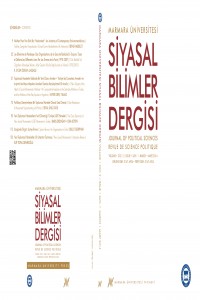Abstract
Gezi Direnişi, yirmi birinci yüzyılın başında gerçekleşen beklenmedik, şaşırtıcı ve özgün bir
toplumsal mücadele olarak toplumsal hareketler tarihindeki yerini almış bulunuyor. Onun ne ifade
ettiği ve nasıl tanımlanacağıysa siyasal iktidar tarafından olduğu kadar sosyal bilimciler ve bizzat
eylemcilerin kendileri tarafından da tartışılmaktadır. Toplumsal hareketleri anlamlandırma ve
tanımlama çabası onları salt talepleri ve somut etkileri üzerinden değerlendiren yaklaşımlara yol
açar. Oysa Gezi Direnişi’nde kanıtlandığı gibi toplumsal hareketler, somut taleplerinin ötesinde
mevcut eşitsizlikleri dönüştürücü bir potansiyele ve alternatif bir toplumsallık arayışına da
sahiptir. Bu makalenin amacı, Gezi Direnişi’ni dile getirilen talepler ve somut etkilerin ötesinde,
sahip olduğu dönüştürücü potansiyel ve özgün bir çoğulluk durumunun mümkün kıldığı politika
deneyimi ekseninde değerlendirmektir.
References
- Anadolu Ajansı (2013) “Kimsenin Gerilimi arttırmaya Hakkı Yok” [çevrimiçi], 1 Haziran, http://www.aa.com.tr/tr/politika/188759--kimsenin-gerilimi-artirmaya-hakki-yok [Erişim 23.12.2013].
- Arendt, H. (1990 [1963]) On Revolution, London: Penguin Books.
- Arendt, H. (1998 [1958]) The Humain Condition, Chicago: The University of Chicago Press.
- Arman, A. (2013) “Yaşasın Y Kuşağı” [çevrimiçi], Hürriyet, 09 Haziran, http://www.hurriyet.com.tr/ yazarlar/23465715.asp [Erişim, 28.11,2013]
- BBC (2013) “Taksim Platformu’nun Taleplerini İçeren Tam Metin” [çevrimiçi], BBC Türkçe Servisi, 5 Haziran, http://www.bbc.co.uk/turkce/haberler/2013/06/130605_taksim_platformu_talepler.shtml [Erişim, 06.06.2013].
- Beetham, D. (1994) “Liberal democracy and the limits of democratization”, David Held (der.), Prospects for Democracy içinde, Oxford: Polity Press.
- Benlisoy, F. (2013) Gezi Direnişi: Türkiye’nin Enteresan Başlangıcı, İstanbul: Agora Kitaplığı.
- Berktay, F. (2012) Dünyayı Bugünde Sevmek: Hannah Arendt’in Politika Anlayışı, İstanbul: Metis Yayınları.
- Çetinkaya, Y. D. (2008) “Tarih ve Kuram Arasında Toplumsal Hareketler”, Y. Doğan Çetinkaya (der.),Toplumsal Hareketler: Tarih, Teori ve Deneyim içinde, İstanbul: İletişim Yayınları, 15-61.
- Easton, D. (1965) A Systems Analysis of Political Life, New York: Wiley.
- Gambetti, Z. (2009) “İktidarın Dönüşen Çehresi: Neoliberalizm, Şiddet ve Kurumsal Siyasetin Tasfiyesi”, İ.Ü. Siyasal Bilgiler Fakültesi Dergisi, 40: 145-166.
- Inglehart, R. (1977) The Silent Revolution: Changing Values and Political Styles, Princeton, Princeton University Press.
Abstract
Gezi Resistance which occurred at the beginning of the twenty first century took place in the history of the social movements as an unexpected, surprising and authentic social struggle. Its significance and the way how to define it is still discussed by social scientists and activists themselves as well as the political power. The effort to interpret and define social movements causes approaches which evaluate them upon their pure claims and concrete effects. However, as it’s proved by Gezi Resistance, social movements have also a transforming potential against * İstanbul Üniversitesi Uluslararası İlişkiler Bölümü Doktora Öğrencisi ve Beykent Üniversitesi Araştırma Görevlisi. E-mail: sevalunlu@hotmail.frexisting inequalities and a search for an alternative sociality beyond their concrete demands. The purpose of this article is to evaluate Gezi Resistance within the frame of its transforming potential and experience of politics enabled by a distinctive plurality case rather than the expressed claims and concrete effects.
References
- Anadolu Ajansı (2013) “Kimsenin Gerilimi arttırmaya Hakkı Yok” [çevrimiçi], 1 Haziran, http://www.aa.com.tr/tr/politika/188759--kimsenin-gerilimi-artirmaya-hakki-yok [Erişim 23.12.2013].
- Arendt, H. (1990 [1963]) On Revolution, London: Penguin Books.
- Arendt, H. (1998 [1958]) The Humain Condition, Chicago: The University of Chicago Press.
- Arman, A. (2013) “Yaşasın Y Kuşağı” [çevrimiçi], Hürriyet, 09 Haziran, http://www.hurriyet.com.tr/ yazarlar/23465715.asp [Erişim, 28.11,2013]
- BBC (2013) “Taksim Platformu’nun Taleplerini İçeren Tam Metin” [çevrimiçi], BBC Türkçe Servisi, 5 Haziran, http://www.bbc.co.uk/turkce/haberler/2013/06/130605_taksim_platformu_talepler.shtml [Erişim, 06.06.2013].
- Beetham, D. (1994) “Liberal democracy and the limits of democratization”, David Held (der.), Prospects for Democracy içinde, Oxford: Polity Press.
- Benlisoy, F. (2013) Gezi Direnişi: Türkiye’nin Enteresan Başlangıcı, İstanbul: Agora Kitaplığı.
- Berktay, F. (2012) Dünyayı Bugünde Sevmek: Hannah Arendt’in Politika Anlayışı, İstanbul: Metis Yayınları.
- Çetinkaya, Y. D. (2008) “Tarih ve Kuram Arasında Toplumsal Hareketler”, Y. Doğan Çetinkaya (der.),Toplumsal Hareketler: Tarih, Teori ve Deneyim içinde, İstanbul: İletişim Yayınları, 15-61.
- Easton, D. (1965) A Systems Analysis of Political Life, New York: Wiley.
- Gambetti, Z. (2009) “İktidarın Dönüşen Çehresi: Neoliberalizm, Şiddet ve Kurumsal Siyasetin Tasfiyesi”, İ.Ü. Siyasal Bilgiler Fakültesi Dergisi, 40: 145-166.
- Inglehart, R. (1977) The Silent Revolution: Changing Values and Political Styles, Princeton, Princeton University Press.
Abstract
References
- Anadolu Ajansı (2013) “Kimsenin Gerilimi arttırmaya Hakkı Yok” [çevrimiçi], 1 Haziran, http://www.aa.com.tr/tr/politika/188759--kimsenin-gerilimi-artirmaya-hakki-yok [Erişim 23.12.2013].
- Arendt, H. (1990 [1963]) On Revolution, London: Penguin Books.
- Arendt, H. (1998 [1958]) The Humain Condition, Chicago: The University of Chicago Press.
- Arman, A. (2013) “Yaşasın Y Kuşağı” [çevrimiçi], Hürriyet, 09 Haziran, http://www.hurriyet.com.tr/ yazarlar/23465715.asp [Erişim, 28.11,2013]
- BBC (2013) “Taksim Platformu’nun Taleplerini İçeren Tam Metin” [çevrimiçi], BBC Türkçe Servisi, 5 Haziran, http://www.bbc.co.uk/turkce/haberler/2013/06/130605_taksim_platformu_talepler.shtml [Erişim, 06.06.2013].
- Beetham, D. (1994) “Liberal democracy and the limits of democratization”, David Held (der.), Prospects for Democracy içinde, Oxford: Polity Press.
- Benlisoy, F. (2013) Gezi Direnişi: Türkiye’nin Enteresan Başlangıcı, İstanbul: Agora Kitaplığı.
- Berktay, F. (2012) Dünyayı Bugünde Sevmek: Hannah Arendt’in Politika Anlayışı, İstanbul: Metis Yayınları.
- Çetinkaya, Y. D. (2008) “Tarih ve Kuram Arasında Toplumsal Hareketler”, Y. Doğan Çetinkaya (der.),Toplumsal Hareketler: Tarih, Teori ve Deneyim içinde, İstanbul: İletişim Yayınları, 15-61.
- Easton, D. (1965) A Systems Analysis of Political Life, New York: Wiley.
- Gambetti, Z. (2009) “İktidarın Dönüşen Çehresi: Neoliberalizm, Şiddet ve Kurumsal Siyasetin Tasfiyesi”, İ.Ü. Siyasal Bilgiler Fakültesi Dergisi, 40: 145-166.
- Inglehart, R. (1977) The Silent Revolution: Changing Values and Political Styles, Princeton, Princeton University Press.
Details
| Primary Language | Turkish |
|---|---|
| Subjects | Political Science |
| Journal Section | Makaleler |
| Authors | |
| Publication Date | July 3, 2014 |
| Published in Issue | Year 2014 Volume: 2 Issue: 1 |

